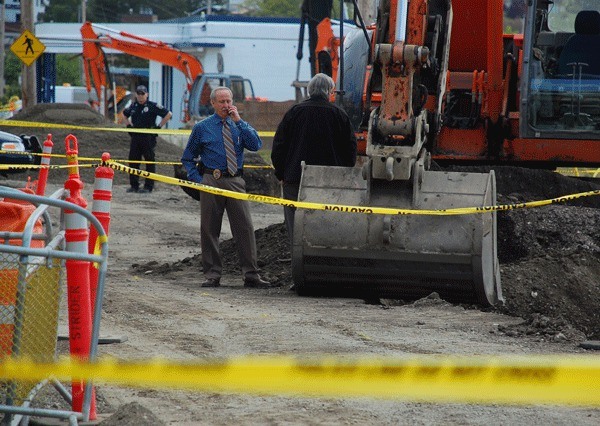A construction worker unearthed what authorities believe to be Native American remains in the midst of the SE Pioneer Way construction project in Oak Harbor Thursday.
At about 8:30 a.m., a backhoe operator was excavating the roadway in front of Mike’s Mini Mart and noticed what appeared to be bones. Work on that section of the project was stopped immediately and city officials notified police.
Upon their arrival, Oak Harbor police detectives cordoned off the area with crime-scene tape and spent several hours inspecting and photographing the remains. Officers were also sent to a Pit Road location that construction workers use as a dump for excavated dirt.
The Island County coroner was also on the scene and, at about 11:30 a.m., Lt. Tim Sterkel announced to a small crowd of eagerly awaiting city officials that the bones had been determined to be human but that this was not a crime scene.
“He (the coroner) thought they were Native American,” said Sterkel, adding that the determination was based largely on the presence of shell midden.
As of Thursday afternoon, it was still unclear whether the remains are from a single individual or multiple people. What appeared to be a femur, a rib bone, and fragments of a skull were found on Pioneer Way.
However, many other bones, some of which are smaller and could have belonged to a child, were found at the Pit Road site. Sterkel said investigators have identified remains in about nine piles of debris.
“Every one of them had bones,” he said. “There could very well be a burial ground.”
News that the bones are in fact human is not what city officials had been hoping to hear. That they are Native American is also problematic because it means possible project delays and additional expense.
“It was not expected and it certainly was not planned for,” City Engineer Eric Johnston said.
State laws are pretty strict when it comes to the preservation of Native American remains and culturally significant areas. Before a project can even begin, municipalities have to hire an archeological firm to review the construction area.
According to Johnston, the city did hire a company in 2009 to survey Pioneer Way for the road project and the firm found no indication of culturally significant resources. But without major excavation, it can be like searching for a needle in a haystack, he said.
“Until you dig up the street, you don’t know what’s under the street,” he said.
According to state law, once something is found all project work around the discovery must cease until a specialist with the state Department of Archaeology and Historic Preservation, or DAHP, can do an inspection.
A physical anthropologist with the state office is scheduled to come out Saturday and evaluate the remains. Until then, the site will be cordoned off and guarded by a city police officer. Sterkel confirmed that the Pit Road location would be under similar guard.
Greg Griffith, deputy state historic preservation officer with DAHP, said it’s difficult to say how the discovery will affect the project schedule over the long term.
“That’s a question that I can’t answer yet,” he said.
The role of DAHP is to not only evaluate the site and the remains but to begin communicating with appropriate tribes to establish identity. The most likely candidates, he said, are the Swinomish Indian Tribal Community and Tulalip Tribes.
“There are probably others but they are the most applicable in this case,” Griffith said.
It’s not yet clear what will happen to the remains. The tribes’ wishes are of paramount concern, and they could opt to remove the bones or leave them where they are. Typically they are removed, but parameters of the construction project can be a factor in the decision, he said.
Initially, Johnston said he was confident the construction project could still be finished by the September deadline. But as additional bones were found throughout the day at the Pit Road site, by 4 p.m. he said he was not longer so confident.
“I think it’s fair to say at this point that we don’t know how it will affect the overall schedule,” Johnston said.
Whether this will mean a significant delay was on the minds of many downtown shop owners. Many stood outside on the dirt street watching the spectacle of officers picking their way around the excavation site.
Mike Shin, owner of Mike’s Mini Mart, said months of construction have taken a heavy toll on his business, reducing revenues by about 50 percent. While he hopes the discovery outside his front window will actually help by steering people downtown, he admits it’s an attempt at optimism.
“I am really unlucky,” he said. “But what can I do.”



